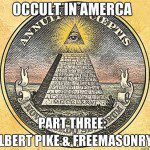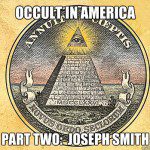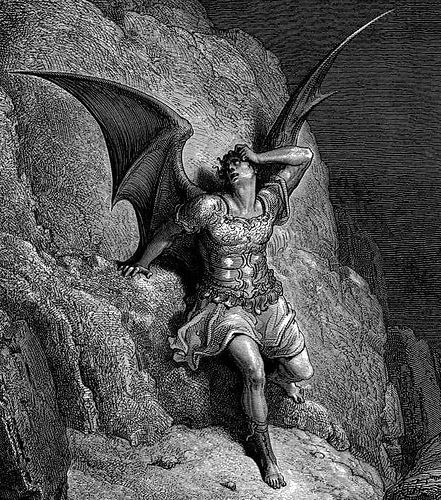(This is not meant to be a complete biography of Johnny Appleseed, or even a complete sketch of the man behind the myth, John Chapman. I’m an admirer, not a biographer, so what follows is woefully incomplete. For more information on Johnny Appleseed there are many sources. Last summer I polished off Howard Means’ Johnny Appleseed: The Man, the Myth, the American Story, which I thoroughly enjoyed. Also thanks to Mitch Horowitz’s Occult America for re-awakening my interest in a child-hood favorite. September 26th being Appleseed’s birthday, I thought the time was appropriate for a little tribute.)
In 1948 The Walt Disney company released a series of shorts as the movie Melody Time. The most well known of those shorts tells the tale of Johnny Appleseed, assuring his place in the pantheon of North American Folklore. I have mixed feelings about the Disney short. In some ways it captures Johnny’s love of the natural world, and in most other ways it, predictably, paints a completely romanticized and cleaned up picture of the man John Chapman.
As you might have guessed, I’m a huge Johnny Appleseed fan. Now I’m not going to argue that the guy was a Pagan or anything ridiculous like that, but he did exist outside the religious mainstream of the United States. Chapman would have been very comfortable singing something like “The Lord’s Been Good to Me*” but the figure portrayed in the cartoon is very different from the real life Johnny Appleseed.
Chapman was born in Massachusetts in 1774, and by the time he was twenty had already moved “West.” West in 1794 meant Pittsburgh Pennsylvania, where he began his carrer as a somewhat successful nurseryman and unsuccessful land speculator. Disney portrayed Chapman as someone who picks apples, but what Chapman really did was grow apple trees. Chapman’s business model was simple: go where you think the next wave of settlers will be, and set up a small apple orchard near by, usually just a few acres surrounded by a fence to keep livestock out. As the Frontier moved westward, Appleseed moved with it, living most of his long life (he died at age 70) in Ohio, before making it as far as Illinois.
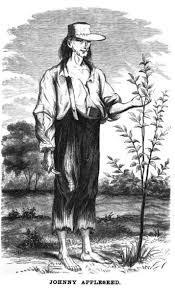
Apple trees were not quite currency in the frontier lands of Ohio, but they were necessary for most homesteaders. The U.S Government required settlers to plant (apple and pear) trees on their property to prove they weren’t land speculators. That requirement is how Chapman made his living. While most of us think of apples as edible, Johnny Appleseed’s apples were often just the opposite. Apple trees are notoriously unpredictable. Put ten apple seeds into the ground from the same tree and you’ll end up with trees producing ten very different kinds of apples. The majority of apples we we eat today come from cuttings or from trees that have had branches grafted onto them. All of Chapman’s trees were grown from seeds, making the fruit they produced more like crab apples than the Golden Delicious and Macintosh varieties we eat today.
If the fruit from Chapman’s trees was inedible, what were they good for? The easy answer is booze, most specifically hard cider and apple jack (which is a super concentrated cider). While hard cider is mostly a boutique drink today, in the 19th Century it was everywhere. (Calling hard cider a “boutique” drink today is not meant as an insult, just a reflection of reality. Long-time readers are well aware of how much I adore love hard cider.) Apple juice was easy to ferment and it became the most common form of alcoholic beverage in large parts of the country. Chapman didn’t grow trees so kids could eat “an apple a day to keep the doctor away” he grew trees because most Americans enjoyed being inebriated. I will refrain from saying Chapman was some sort of Frontier-Dionysus even though I want to make the claim in the worst way.
While Disney portrayed Chapman as someone rather rational and sane, the real life Johnny Appleseed was quite different. Chapman tended to keep to himself and sleep in the woods, he was basically homeless for much of his life. He was rather unconcerned with clothes, tending to walk around barefoot (even in the winter) and wearing whatever scraps he could find for clothing. He turned burlap bags into pants. The cooking pot that often appears on Chapman’s head in paintings and drawings is surprisingly accurate, though later in life his head-ware became even stranger. Some observers recalled him wearing three hats at the same time; a brim, the cooking pot, and then a crown on top.
If it sounds like Appleseed was a bit disturbed, you might be right. There are unconfirmed stories claiming that he was kicked in the head by a horse in his mid-20’s and was never quite the same again. His eccentric nature might have also been the result of a broken heart. Allegedly the object of his affection accepted a competing suitor’s marriage proposal just one day before Chapman was going to pop the question, this resulted in him becoming rather bitter. Observers of the real life Appleseed recalled him getting extremely angry when recounting the tale. After the rejection Chapman never pursued another woman, but did claim to have two spirits waiting for him in heaven committed to being his wives.
No, Chapman wasn’t a protege of Joseph Smith (founder of the Mormons, they both came later) he was a believer in The New Church, a radical Christian sect based on the teachings of Swedish mystic Emmanuel Swedenborg**. The New Church denied the Christian trinity and the concept of original sin. Followers of Swedenborg also believed that actions, and not faith alone, assured a place in the highest heaven. Swedenborg also claimed to have visited various levels of heaven and hell and to have spoken with angels (along with spirits from various planets and the moon). It’s this last bit, being able to carry “the news of heaven” down to Earth that probably most intrigued Chapman.
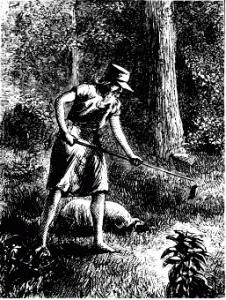
Even though he was a loner, Chapman was a kind hearted soul and got along well with others, especially children. There are dozens of stories of the man entertaining kids with tales and tricks (including the sticking of pins into the soles of his feet), and giving them small gifts. Chapman’s charity extended to nearly everyone, and he was just as likely to give away a tree as to sell one. Much of the Appleseed legend came as a result of Chapman’s generosity.
Appleseed didn’t just believe in doing good by people, his kindness extended deep into the animal kingdom. He often purchased wounded and abused horses, going so far as to buy a few acres of land so they would have a place to graze. There’s a story of how he put out a campfire once on a cold night because mosquitos kept flying into it! For much of his life Chapman was a vegetarian and got by on what he could forage from the woods or what was given to him by others.
Concern for the natural world, apples for cider, and direct experience with the divine . . . except for the grubby clothes and lack of shoes I totally sympathize with the real world John Chapman. He may not have been the character portrayed by Disney, but the real man was far more fascinating. When it comes to American Folklore, my favorite will always be Johnny Appleseed.
*If you didn’t click on the Youtube video, you are missing out on my favorite minute of Disney music ever.
**In a perfect world I would turn this into a 4,000 word post and share a ton of information with you about Swedenborg and his importance to the New Age movement and in some ways, Modern Paganism. I realize I’m not giving Swedenborg the detail he deserves. However, this post is already 1400 words long and I worry enough about making my blog posts far too wordy.









